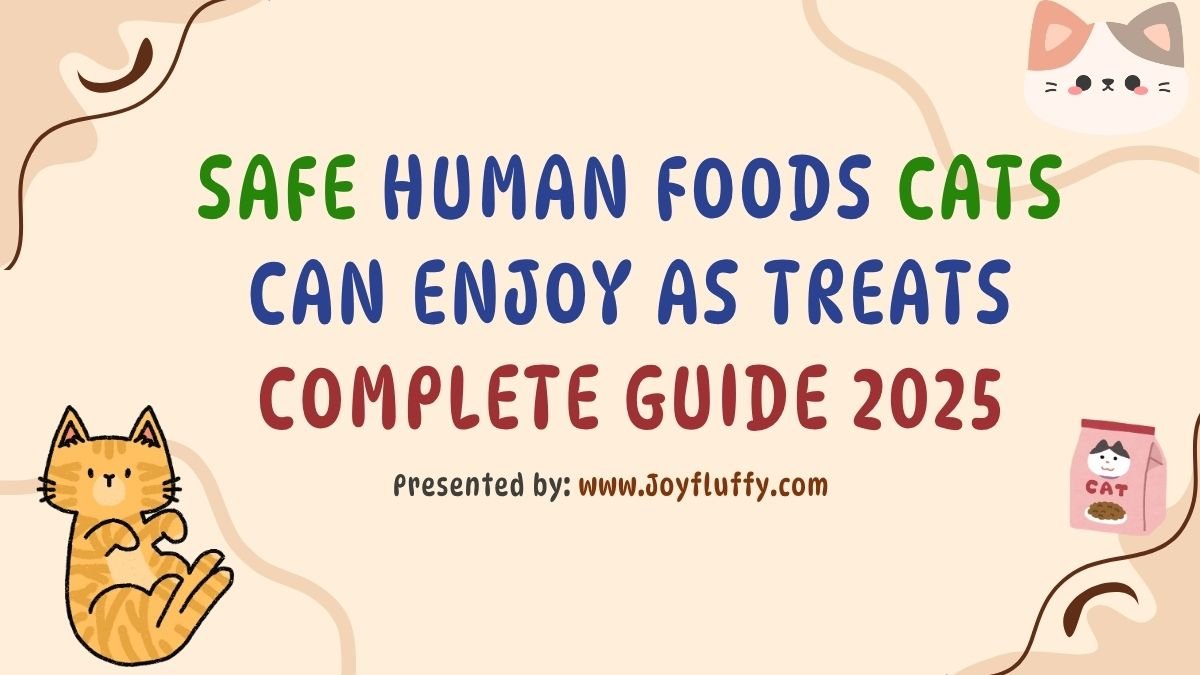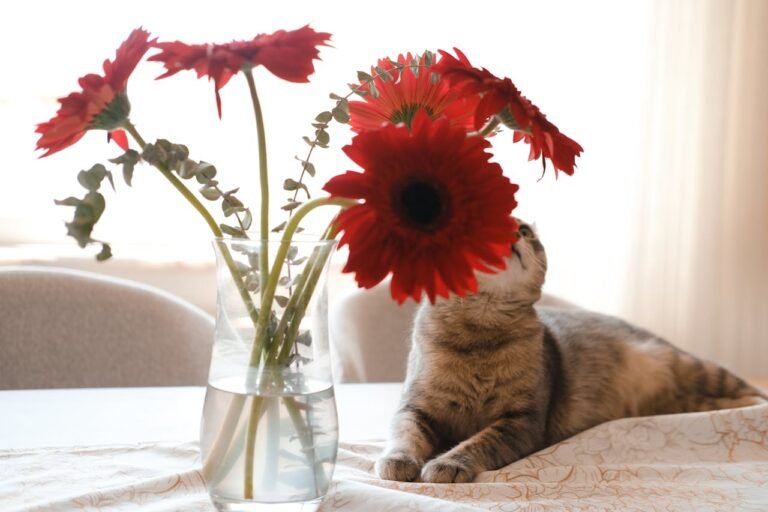Safe Human Foods Cats Can Enjoy as Treats | Complete Guide 2025
🐱 Safe Human Foods Cats Can Enjoy as Treats
As loving cat owners, we often find ourselves wanting to share our meals with our feline companions. Those adorable pleading eyes can be hard to resist! However, not all human foods are safe for cats. Understanding which safe human foods cats can enjoy as treats is essential for keeping your furry friend healthy and happy. This comprehensive guide will walk you through the best human foods you can safely share with your cat, along with important preparation tips and warnings about foods to avoid.
Understanding Your Cat’s Nutritional Needs
Before diving into the list of safe human foods cats can enjoy as treats, it’s crucial to understand that cats are obligate carnivores. This means their bodies are designed to derive nutrition primarily from animal-based proteins. Unlike dogs and humans, cats require certain nutrients like taurine, arachidonic acid, and vitamin A that are found naturally in animal tissues.
While cats can process some plant-based foods in small amounts, their digestive systems are optimized for meat. This is why any human food treats should complement, not replace, their regular cat food. A balanced commercial cat food provides all the essential nutrients your cat needs, and human foods should only constitute about 10% of their daily caloric intake.
Understanding these nutritional requirements helps explain why some foods that are perfectly healthy for humans may not provide the same benefits for cats. It also emphasizes the importance of moderation when offering safe human foods cats can enjoy as treats. For more insights on maintaining your cat’s overall wellbeing, check out this comprehensive guide to popular cat lifestyle practices.
Protein-Rich Safe Human Foods for Cats
Cooked Chicken
Plain, cooked chicken is one of the safest and most nutritious human foods you can share with your cat. Chicken provides high-quality protein and essential amino acids that support muscle development and maintenance. When preparing chicken for your cat, ensure it’s thoroughly cooked without any bones, skin, or seasoning. Boiled or baked chicken breast works best. Cut it into small, bite-sized pieces to prevent choking and make it easier for your cat to digest.
Turkey
Similar to chicken, plain cooked turkey is an excellent protein source for cats. Turkey contains tryptophan, which can have a calming effect, and provides selenium and phosphorus for overall health. Remove all skin, bones, and fatty portions before offering turkey to your cat. Avoid deli turkey or processed turkey products, as these often contain high levels of sodium and preservatives that aren’t suitable for cats.
Lean Beef
Cooked lean beef in small amounts can be a tasty treat for cats. Beef provides iron, zinc, and B vitamins that support various bodily functions. Choose lean cuts and cook them thoroughly without any oils, butter, or seasonings. Ground beef should be cooked until well done and drained of excess fat. Remember that beef should be an occasional treat rather than a regular part of your cat’s diet.
🐟 Cooked Fish
Salmon, tuna, and whitefish are safe in moderation. Rich in omega-3 fatty acids for healthy skin and coat. Always cook thoroughly and remove all bones.
🥚 Cooked Eggs
Scrambled or boiled eggs provide excellent protein and vitamins. Never feed raw eggs. Cook without butter, oil, or seasonings for best results.
🍤 Cooked Shrimp
Plain cooked shrimp offers protein and minerals. Remove shells and tails completely. Serve in very small portions as an occasional treat.
Safe Dairy Products for Cats
The relationship between cats and dairy is complicated. While many people picture cats happily lapping up milk, the reality is that most adult cats are lactose intolerant. However, some dairy products contain less lactose and can be tolerated in small amounts.
Hard Cheeses
Small amounts of hard cheeses like cheddar, Swiss, or parmesan can be safe for some cats. These cheeses have less lactose than soft cheeses or milk because the fermentation process breaks down much of the lactose. Offer only tiny pieces as an occasional treat and monitor your cat for any signs of digestive upset. If you notice diarrhea, vomiting, or excessive gas after giving cheese, discontinue immediately.
Plain Yogurt
Unsweetened, plain yogurt in very small amounts may be tolerated by some cats. The live cultures in yogurt can actually aid digestion for cats who can tolerate it. However, avoid flavored yogurts, especially those containing artificial sweeteners like xylitol, which is toxic to pets. A tiny spoonful once in a while is more than enough.
Important Note: Never give your cat cow’s milk. Despite popular belief, milk can cause digestive problems in most cats. If your cat shows any signs of lactose intolerance such as diarrhea, bloating, or vomiting after consuming dairy, avoid giving them any dairy products in the future.
Fruits and Vegetables Cats Can Eat
While cats don’t require fruits and vegetables in their diet, some can be offered as occasional treats and may provide additional fiber and vitamins. Remember that cats cannot taste sweetness, so they may not find fruits as appealing as we do.
Safe Vegetables
Cooked Carrots: Soft, cooked carrots cut into small pieces can provide beta-carotene and fiber. Raw carrots are too hard and pose a choking hazard, so always cook them until soft.
Green Beans: Plain, cooked green beans are low in calories and can be a good source of fiber. Some cats actually enjoy the texture of green beans. They can be steamed or boiled but should never be seasoned.
Peas: Small amounts of cooked peas are safe and provide protein, fiber, and vitamins. You’ll find peas in many commercial cat foods, making them one of the more commonly accepted vegetables for felines.
Pumpkin: Plain, cooked pumpkin (not pumpkin pie filling) is excellent for digestive health. Many veterinarians recommend pumpkin for cats with constipation or diarrhea. A teaspoon of pure pumpkin puree can work wonders for digestive issues.
Spinach: Cooked spinach in very small amounts provides vitamins and minerals. However, cats with kidney or urinary tract issues should avoid spinach due to its calcium oxalate content.
Safe Fruits
Blueberries: These antioxidant-rich berries are safe for cats in small quantities. Some cats enjoy batting them around before eating them, making them both a treat and a toy.
Watermelon: Seedless watermelon flesh (never the rind) can be hydrating and refreshing. Cut into small cubes and offer sparingly, as the high water content can cause digestive upset if given in large amounts.
Bananas: While safe, bananas are high in sugar and should be given very rarely. A tiny slice occasionally won’t harm your cat, but they shouldn’t become a regular treat.
Apples: Small pieces of apple flesh without seeds or core can be offered. Apple seeds contain cyanide and must never be given to cats. The flesh should be cut into very small pieces to prevent choking.
Whole Grains and Carbohydrates
Cats have limited ability to digest carbohydrates compared to omnivores, but small amounts of certain grains can be safe as occasional treats.
Cooked Rice
Plain white or brown rice, cooked soft, can help settle an upset stomach. Many veterinarians recommend rice as part of a bland diet for cats recovering from digestive issues. Offer only small amounts, as cats don’t derive significant nutrition from rice.
Oatmeal
Plain, cooked oatmeal without any sweeteners or flavorings can be given in tiny amounts. Oatmeal provides some fiber and can be soothing for the digestive tract. However, many cats simply aren’t interested in oatmeal due to its texture and lack of meat flavor.
Bread
Small pieces of plain, baked bread are generally safe but offer no nutritional value to cats. Never give your cat raw bread dough, as the yeast can expand in their stomach and cause serious health issues. Bread should only be an extremely rare treat if your cat shows interest.
⚠️ Foods That Are Toxic to Cats
While we’re discussing safe human foods cats can enjoy as treats, it’s equally important to know which foods are dangerous. Never feed your cat any of the following:
- Onions and Garlic: All forms (raw, cooked, powdered) can damage red blood cells and cause anemia
- Chocolate: Contains theobromine, which is toxic to cats and can cause heart problems and seizures
- Grapes and Raisins: Can cause kidney failure, even in small amounts
- Alcohol: Extremely toxic and can cause severe liver and brain damage
- Caffeine: Found in coffee, tea, and energy drinks; can cause heart palpitations and tremors
- Xylitol: This artificial sweetener causes liver failure and life-threatening drops in blood sugar
- Raw Dough: Yeast expands in the stomach and can cause bloating and alcohol poisoning
- Macadamia Nuts: Can cause weakness, tremors, and hyperthermia
- Avocado: Contains persin, which can cause vomiting and diarrhea in cats
- Raw Meat and Fish: Risk of bacterial contamination and parasites
How to Safely Introduce New Foods
When offering safe human foods cats can enjoy as treats for the first time, it’s essential to introduce them gradually and carefully. Here’s a step-by-step approach to ensure your cat’s safety and comfort.
Start with a very small amount—about the size of a pea or smaller. Observe your cat for the next 24 to 48 hours for any signs of adverse reactions. Look for symptoms such as vomiting, diarrhea, excessive scratching, lethargy, or changes in behavior. If your cat shows any concerning symptoms, discontinue the food immediately and consult your veterinarian.
If your cat tolerates the new food well, you can gradually increase the portion size over several days, but always keep it small. Remember that treats should never exceed 10% of your cat’s daily caloric intake. For an average 10-pound cat, this equals roughly 20-30 calories from treats per day.
Consider your individual cat’s health conditions. Cats with diabetes, kidney disease, inflammatory bowel disease, or food allergies may have additional dietary restrictions. Always consult with your veterinarian before introducing new foods if your cat has any health conditions or is on a special diet.
💡 Expert Tips for Feeding Human Foods to Cats
- Temperature Matters: Serve food at room temperature. Food that’s too cold or too hot can upset your cat’s stomach or burn their mouth.
- Cut into Small Pieces: Always cut treats into bite-sized pieces appropriate for your cat’s size to prevent choking hazards.
- No Seasonings: Never add salt, pepper, garlic powder, onion powder, or any other seasonings. What tastes good to us can be harmful to cats.
- Remove Bones: All bones should be removed from meat and fish, as they can splinter and cause choking or internal injuries.
- Fresh is Best: Only offer fresh food. Leftovers that have been sitting out should not be given to cats due to bacterial growth.
- Hydration: Ensure your cat always has access to fresh water, especially when introducing new foods.
- Storage: If preparing treats in advance, store them properly in the refrigerator and use within 1-2 days.
- Individual Preferences: Not all cats will like all safe foods. Respect your cat’s preferences and never force them to eat something.
Portion Control and Frequency
One of the most critical aspects of feeding safe human foods cats can enjoy as treats is maintaining appropriate portion sizes and frequency. Overfeeding treats, even healthy ones, can lead to obesity and nutritional imbalances.
A good rule of thumb is the 90/10 rule: 90% of your cat’s calories should come from complete and balanced cat food, while only 10% should come from treats and human foods. For most cats, this means no more than one or two small treats per day.
Consider the caloric density of different foods. A small piece of cheese might contain significantly more calories than the same-sized piece of cooked chicken breast. High-fat treats should be given even more sparingly than lean protein treats.
Frequency is just as important as portion size. It’s better to offer a tiny treat once or twice a week than to make human food a daily expectation. This approach helps maintain the special nature of treats while minimizing the risk of nutritional imbalances or weight gain.
Pay attention to your cat’s body condition. If you notice weight gain after introducing human food treats, reduce the frequency or portion size, or eliminate them entirely. Your cat’s health should always be the top priority.
Special Considerations for Different Life Stages
Kittens
Kittens require specially formulated food to support their rapid growth and development. While safe human foods cats can enjoy as treats can be introduced to kittens, they should be given even more sparingly than to adult cats. Focus primarily on high-quality kitten food that provides all necessary nutrients. If you do offer treats, stick to tiny amounts of plain cooked chicken or fish.
Senior Cats
Older cats may have dental issues, reduced digestive capacity, or chronic health conditions that affect their dietary needs. Softer foods like mashed cooked vegetables or well-cooked, finely shredded chicken may be easier for senior cats to eat. However, senior cats with kidney disease, diabetes, or hyperthyroidism may need to avoid certain foods entirely. Consult with your veterinarian about appropriate treats for your senior cat.
Cats with Health Conditions
Cats with specific health conditions require extra caution when it comes to treats. Diabetic cats need low-carbohydrate options and careful blood sugar monitoring. Cats with kidney disease should avoid high-phosphorus foods and may need restricted protein. Cats with food allergies or sensitivities may need to stick to hypoallergenic options only. Always work with your veterinarian to determine safe treat options for cats with health issues.
Reading Your Cat’s Body Language
Understanding how your cat responds to new foods is crucial for their safety and enjoyment. Cats communicate their preferences and discomfort through body language, and paying attention to these signals can help you identify foods your cat enjoys and those that may cause problems.
Positive signs include eager approach to the food, normal eating pace, purring or contentment after eating, and maintaining normal activity levels afterward. If your cat shows these signs, the food is likely well-tolerated and enjoyed.
Negative signs include backing away from food, sniffing and walking away, eating reluctantly or spitting out food, or showing lethargy after eating. If you notice these behaviors, the food may not agree with your cat or they simply don’t like it.
According to veterinary nutrition experts at the American Veterinary Medical Association, understanding your pet’s individual reactions to foods is essential for maintaining their health and wellbeing.
Creating a Balanced Treat Routine
Establishing a healthy treat routine helps prevent overfeeding while maintaining the special bond that sharing food creates. Here’s how to create a balanced approach to feeding safe human foods cats can enjoy as treats.
First, designate specific times for treats rather than giving them randomly throughout the day. This helps your cat understand when to expect treats and prevents constant begging. Many cat owners find success with one small treat in the morning and one in the evening.
Keep a treat journal for the first few weeks of introducing new foods. Record what you gave, how much, and any reactions. This documentation can be invaluable if your cat develops any health issues and your veterinarian needs to review their diet history.
Rotate different safe foods to provide variety and prevent boredom. However, don’t introduce multiple new foods at once, as this makes it difficult to identify which food might cause a problem if one occurs.
Use treats strategically for training or medication administration. A small piece of chicken can be an excellent reward for good behavior or can help mask the taste of medication when needed.
Common Questions About Feeding Human Food to Cats
Will feeding human food make my cat refuse their regular food?
This is a valid concern, but it’s usually only a problem when human food treats become too frequent or make up too large a portion of the diet. By following the 90/10 rule and offering treats sparingly, most cats will continue to enjoy their regular food. If your cat does become picky, simply stop the treats for a few days until they return to eating their regular food normally.
Can I use human food to help my cat gain or lose weight?
While it might seem helpful to add extra protein for weight gain or vegetables for weight loss, this should only be done under veterinary supervision. Weight management requires carefully calculated caloric intake and specific nutrient ratios. Your veterinarian can recommend appropriate foods and portions based on your cat’s individual needs.
Is homemade cat food better than commercial cat food?
Commercial cat foods are formulated to meet all of your cat’s nutritional requirements and undergo rigorous testing. While homemade diets can be healthy, they require careful planning with a veterinary nutritionist to ensure they’re complete and balanced. Simply feeding various safe human foods cats can enjoy as treats does not constitute a complete diet and should not replace commercial cat food unless specifically designed by a professional.
The Importance of Quality Cat Food as the Foundation
While this guide focuses on safe human foods cats can enjoy as treats, it’s essential to emphasize that these treats should supplement, not replace, high-quality commercial cat food. Modern cat foods are scientifically formulated to provide complete and balanced nutrition for your feline friend.
Commercial cat food contains precise ratios of protein, fats, carbohydrates, vitamins, and minerals that cats need for optimal health. They include essential nutrients like taurine, which cats cannot produce themselves and must obtain from their diet. Taurine deficiency can lead to serious health problems including heart disease and blindness.
When selecting cat food, look for products that meet AAFCO (Association of American Feed Control Officials) standards. These foods have been tested to ensure they provide complete nutrition. Choose foods appropriate for your cat’s life stage, whether kitten, adult, or senior.
Reading ingredient labels helps you understand what you’re feeding your cat. The first few ingredients should be high-quality protein sources like chicken, fish, or turkey. Avoid foods with excessive fillers, artificial colors, or unnamed meat by-products.
Building Positive Associations with Safe Treats
Sharing safe human foods cats can enjoy as treats can strengthen the bond between you and your cat while making certain activities more positive. Here are some beneficial ways to use treats:
Veterinary Visits: Bringing a small container of your cat’s favorite safe treat to the vet can help create positive associations with what’s often a stressful experience. A tiny piece of chicken after an examination can help your cat feel rewarded for their cooperation.
Grooming Sessions: If your cat tolerates nail trimming or brushing better with food motivation, a small treat afterward can make these necessary tasks less stressful for both of you.
Training and Mental Stimulation: While cats are often thought of as untrainable, they can actually learn commands and tricks quite well with proper motivation. Small treats can be used to teach behaviors like coming when called, sitting, or using a scratching post.
Bonding Time: Simply sitting with your cat and occasionally offering a tiny treat while petting them can deepen your relationship. This quiet time together, enhanced by the occasional special snack, helps build trust and affection.
Environmental Enrichment Through Food
Safe human foods cats can enjoy as treats can also be used for environmental enrichment, which is crucial for indoor cats’ mental and physical health. Here are creative ways to use treats for enrichment:
Puzzle Feeders: Place small pieces of cooked chicken or fish in puzzle feeders to encourage natural hunting behaviors. This provides mental stimulation and slows down eating, which can be beneficial for cats who eat too quickly.
Foraging Games: Hide tiny treats around your home to encourage exploration and activity. This mimics the natural hunting and foraging behaviors cats would exhibit in the wild.
Ice Cube Treats: On hot days, freeze small pieces of cooked chicken or fish in ice cubes. As the ice melts, your cat gets both hydration and a cool treat. This is especially beneficial for cats who don’t drink enough water.
Interactive Play: Use treats as rewards during play sessions with toys. This creates positive associations with exercise and helps maintain a healthy weight.
Veterinary Consultation: Before making any significant changes to your cat’s diet or introducing multiple new foods, consult with your veterinarian. They can assess your cat’s individual health status, current diet, and any potential concerns specific to your cat. This is especially important for cats with existing health conditions, senior cats, or cats on prescription diets.
Recognizing and Responding to Food Allergies
While uncommon, cats can develop food allergies or sensitivities to certain ingredients. When introducing safe human foods cats can enjoy as treats, it’s important to recognize potential allergic reactions.
Common signs of food allergies in cats include excessive scratching or grooming, skin redness or rashes, ear infections, vomiting or diarrhea, swollen face or paws, and changes in coat quality. If you notice any of these symptoms after introducing a new food, discontinue it immediately and consult your veterinarian.
The most common food allergens for cats are beef, fish, and dairy products. While these can be safe for most cats in moderation, some individuals may react adversely. This is why the gradual introduction of new foods is so important—it allows you to identify the specific ingredient causing problems.
If your cat has been diagnosed with food allergies, stick strictly to their prescribed diet unless your veterinarian approves specific treats. Many cats with allergies do best on limited-ingredient diets with novel proteins they haven’t been exposed to before.
Seasonal and Occasional Treat Ideas
Different seasons and occasions can provide opportunities to offer special treats to your cat, always keeping safety in mind.
Summer Treats
During hot weather, frozen treats can help keep your cat cool. Try freezing small amounts of low-sodium chicken broth in ice cube trays for a refreshing snack. Small pieces of seedless watermelon can also provide hydration. Always ensure these treats are appropriately sized to prevent choking.
Holiday Considerations
During holidays, you might feel tempted to share special foods with your cat. While plain, cooked turkey at Thanksgiving can be safe, avoid anything with gravy, stuffing, or seasonings. Never give cats anything containing onions, garlic, or excessive salt, which are common in holiday dishes.
Birthday Celebrations
If you want to celebrate your cat’s birthday or adoption day, consider making a special treat plate with tiny portions of several safe foods they enjoy. A small piece of cooked chicken, a bit of plain fish, and a few cooked carrot pieces can create a special “meal” without overfeeding.
Travel and Safe Treat Storage
If you travel with your cat, bringing familiar treats can help reduce stress. However, proper storage is crucial to prevent spoilage and maintain food safety.
Pack treats in airtight containers and keep them cool if traveling for more than a few hours. Dry treats like small pieces of freeze-dried chicken are often more practical for travel than fresh cooked meats. Always bring enough of your cat’s regular food for the entire trip plus extra in case of delays.
When staying in hotels or unfamiliar locations, maintain your cat’s regular feeding schedule as much as possible. The familiar routine, including their occasional treats, can provide comfort in an unfamiliar environment.
🎯 Quick Reference: Best Practices Summary
- Moderation is Key: Treats should never exceed 10% of daily calories
- Protein First: Focus on lean, cooked meats as the safest treat options
- Always Cook: Never feed raw meat, fish, or eggs to prevent bacterial contamination
- No Seasonings: Plain, unseasoned food only
- Remove Hazards: All bones, seeds, pits, and inedible parts must be removed
- Size Appropriately: Cut all treats into small, manageable pieces
- Introduce Gradually: One new food at a time with careful monitoring
- Watch for Reactions: Monitor for 24-48 hours after introducing new foods
- Consult Your Vet: Especially important for cats with health conditions
- Maintain Balance: High-quality cat food should always be the foundation of your cat’s diet
Final Thoughts on Sharing Safe Foods with Your Cat
Understanding which safe human foods cats can enjoy as treats allows you to strengthen your bond with your feline companion while maintaining their health and wellbeing. The key to success lies in moderation, proper preparation, and careful observation of your cat’s individual responses.
Remember that every cat is unique. What one cat loves, another might ignore. What agrees with one cat’s digestive system might upset another’s. This individuality makes it essential to approach treat-giving as a gradual, mindful process rather than following a one-size-fits-all approach.
The foundation of your cat’s diet should always be high-quality, nutritionally complete cat food. Human food treats, no matter how safe and healthy, are supplements to this foundation, not replacements. They’re opportunities for bonding, training, and occasional indulgence, but they should never compromise your cat’s nutritional needs.
By following the guidelines in this comprehensive guide, you can safely share appropriate human foods with your cat, creating positive experiences and memories together. Always prioritize your cat’s health, consult with your veterinarian when in doubt, and enjoy the special moments that come from treating your beloved feline friend.
Your cat depends on you to make wise decisions about their diet and health. By being informed, cautious, and attentive to their needs, you’re providing the best possible care while still enjoying those adorable moments when you can share a safe, healthy treat together.






2 Comments